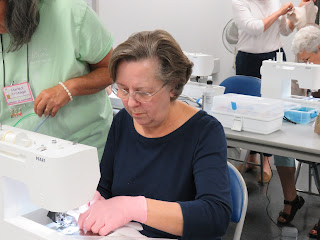 |
| The first ingredient of a beautiful gown is quality fabric |
 |
| The next elements needed are experience and expertise. These ladies fulfill these qualification with a combined knowledge of over 100 years of sewing skills and hand work! |
 |
| Cutting the sleeves, front and back bodices requires a steady hand. |
 |
| The next step is to attach lace to sleeves or hemline on certain gowns. |
 |
| And now the construction of the gown begins... |
 |
| Many hands make the workload easier and great fun! This was the first meeting for this very new member |
 |
| These 2 new members came prepared with scissors in hand to trim the seams of the gowns before they were pressed and ready for pleating. |
 |
| This member knows the difference between ironing and pressing and creates just the right turn down along the neckline for the pleating. |
 |
| The labor intense pleating activity takes patience and time as well as the ability to not become frustrated with broken needles. |
From the ironing
board to the pleater the process follows
a flow to
make enough
gowns for our
members to smock...
 |
| There are still a few more steps to the pleating process so several members bring their pleaters to move the gowns along the assembly line. |
No matter if you are a grandmother or a granddaughter, your sewing gifts and talents are essential for the success of our community service venture to the bereavement programs in local hospitals.
 |
| Gathering the finish gowns to mark the size and insert into individual baggies to keep them nice and neat for the members to smock... |
 |
| Cutting the ribbon needed to gather the gowns at the neckline and hems. |

No comments:
Post a Comment